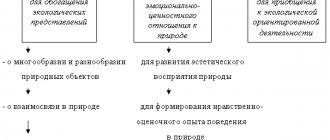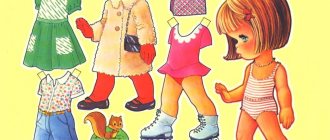A distinctive feature of children is that they perceive any information better in games, since the gaming component increases interest in the process, enhances attention and concentration, and repeated repetitions allow even the most absent-minded kids to absorb knowledge. The competitive moment is very important for born leaders. During the game, a child’s character, peculiarities of imagination and thinking, activity, emotionality, level of social adaptation and a progressive need for contact and communication are revealed.
Didactic games for speech development are a special form of education for preschool children, which allows you to enrich, improve, activate and consolidate vocabulary in the process of play - one of the most important means of harmonious formation and education of a child’s personality.
Depending on the material used, didactic games for speech development are of the following types:
- Games with objects - toys, improvised and natural materials;
- Board games using printed materials;
- Word games.
Speech development through didactic games
The development of speech through didactic games occurs by replenishing vocabulary, teaching in a playful way the skills of using words (activating vocabulary), and improving communication skills.
During the period of preschool preparation, the child needs to master a vocabulary that allows him to communicate without problems with peers and adults, successfully acquire school knowledge, and understand the material presented (the content of literary works, the formulation of mathematical problems, etc.). Therefore, the main task of preschool education is the maximum development of speech, which occurs more effectively and efficiently through didactic games.
Didactic games for speech development successfully solve the following problems in preschool education of children:
- Provide quantitative accumulation of vocabulary necessary for full communication;
- Helps in understanding the meanings of words and their correct use with other words;
- Allows you to master the general meanings of words based on identifying common characteristic features of objects, actions or phenomena;
- Improve figurative thinking and its expression by verbal description, thanks to the use of special speech constructions;
- As cognitive abilities develop, didactic games for speech development help expand the objective conceptual content of words;
- Some games with ethical tasks, along with improving vocabulary, teach the inclinations of social ethics and morality;
- Stimulate the imagination, activating and enriching the preschooler’s vocabulary in an entertaining playful way;
- Develop logical and imaginative thinking necessary to solve assigned game problems;
- They not only help expand your vocabulary, but also actively introduce new words into everyday communication.
The vocabulary of a preschooler is significantly inferior in volume to the vocabulary of an adult. The main task of speech development through didactic games is to quantitatively enrich the child’s vocabulary by increasing the volume of accumulated knowledge about the world around him, to activate and teach him to use it competently.
How can a teacher develop the speech of preschoolers through play?
Content
What speech problems did the teacher have to cope with? What areas of work did the teacher choose? We had to teach children to play again. Playing with children: a “time machine” for parents “Morning circle”: what are your plans for the day? What results have you achieved? What toys for speech development can a teacher recommend?
The development of speech in preschool children occurs during play. In kindergarten, the schedule is overcrowded, and there is less and less time for play. This has a bad effect on the formation of speech competencies. “ In today's kindergartens, the second half of the day is occupied by clubs. If previously children did nothing but play, now they have about an hour a day to play, instead of the required 3-4 hours. As a result, children do not know how to play or communicate. It's gotten to the point where we're teaching kids how to play again.
“says psychologist
Svetlana Bashinova
.
Teacher of preschool educational institution No. 36 in Kineshma in the Ivanovo region Yulia Vladimirovna Vinogradova
, a resident of the “University of Childhood” community, encountered a similar problem in practice.
The teacher spoke about her project “ We play - we develop speech
,” with the help of which she decided to change the current state of affairs in kindergarten.
What speech problems did the teacher have to cope with?
In the process of working with preschoolers, Yulia Vladimirovna noted that children’s speech is poorly developed: “ Everyone can speak, but only a few can speak correctly.”
" At the same time, the Federal State Educational Standard for preschool education assigns speech a leading place in cognitive activity.
The problem could not be ignored, dooming the children to difficulties in further education at school.
Julia formulated a number of speech disorders that had to be dealt with:
● Poor vocabulary
Children do not have enough words to accurately express their thoughts, which causes the formation of barriers in communication with each other and with adults.
● Monosyllabic speech
85% of preschoolers' speech consists of simple sentences. Attempts to correctly construct a common sentence are often unsuccessful.
● Lack of logic of statement
Children are inconsistent in substantiating their statements and conclusions. While telling something, they switch from one thought to another randomly, without adhering to a specific structure.
● Inability to build a dialogue
Preschoolers do not understand how to clearly formulate their question and how best to answer their interlocutor. They do not feel in which speech situation a monosyllabic answer is appropriate and in which a detailed answer.
● Insufficient development of speech culture
Children, for example, have a hard time adjusting the volume of their voice: they either mutter something under their breath or scream. There are also difficulties with intonation and tempo: either the speech is slow, drawn-out, difficult to understand, or, on the contrary, it is too fast to catch the essence.
● "Littering" of speech with slang
At preschool age, children are not yet able to filter the words they hear and apply them according to the situation, or not use them at all. From the TV screen, on the street, or even from their parents, they snatch filler words, non-literary expressions that they use without thinking.
What areas of work did the teacher choose?
Yulia Vladimirovna identified for herself at the initial stage four main areas of work:
➢ Creation of a developing subject-spatial environment in kindergarten.
➢ Returning role-playing games to children’s daily activities.
➢ Improving interaction between parents and children through activities in kindergarten: the “Playing with Children” technology.
➢ Formation of the skill of exchanging opinions and plans, analysis, and logical construction of a story: the “Morning Circle” technology.
The children had to be re-taught how to play.
“I think it’s not that children began to play less,” says Yulia, “the quality and essence of the game have changed. More primitive forms appeared. Increasingly, the game turns into mischief and even hooliganism.”
There are many toys in kindergarten, which themselves suggest a scenario for their use. As a result, children fantasize less. They use familiar plots from their favorite cartoons - “Smeshariki”, “Barboskiny” - repeat what they have already come up with for them.
To return role-playing games to the world of preschoolers, the teacher began to change the subject-play environment of the kindergarten. She offered the children objects that, at first glance, were not suitable for play: “I removed the ready-made equipment and put in boxes, boxes, and disks.”
Having lost their usual tools, the children began to figure out how to use objects in the play corner to make it interesting and use their imagination. The unfamiliarity of the situation provoked independent communication between the children: they had to negotiate with each other and formulate rules in each individual case.
Teachers monitored the children’s communication from the outside and intervened in the situation only when help was needed in solving a problem or a conflict was brewing. Based on the design of the children's game and their ideas, teachers could remind children about the books they had read. The guys, in turn, developed the basis of the plot and came up with continuations of their favorite fairy tales.
Playing with children: a “time machine” for parents
Understanding that children receive the basis for speech development in the family, Yulia Vladimirovna invited her parents to play in the garden. It worked like a “time machine”: adults got a chance to return to childhood, and children saw mom and dad in an unusual role and took responsibility for the course of the game. They used all the power of their persuasion to teach adults to follow the rules. For some families, these hours of communication became a unique experience, because at home they hardly spent time together.
“Morning circle”: what are your plans for the day?
The “Morning Circle” was used by the teacher as one of the ways to organize free communication. The teacher and the children sat in a circle and discussed the future day: what the children planned to do, what to play, what they would like to do. Children offer ideas and openly express their opinions. They felt that they could choose, there was no pressure on them. A sense of mutual respect was fostered, and the ability to convey one’s thoughts to comrades was developed.
Preschoolers talked about the games they had already played: what they liked, what they didn’t, and why. In addition to analytical skills, the skill of reasoned defense of one’s position was developed.
What results have you achieved?
After several months of regular classes, the teacher noted changes that had occurred with the children in her group:
✔ Learned how to build a story.
Children spoke confidently and with the help of detailed sentences about themselves and made up stories for the heroes of joint games. They could even write fairy tales.
✔ They began to show speech initiative.
They became less and less withdrawn into themselves and saw no problem in entering into dialogue. Social and communication skills have strengthened.
✔ Independence and activity in the game appeared.
The children stopped waiting for the teacher to come and entertain them. Now they knew how to negotiate and came up with games on their own.
✔ Child-parent relationships have improved.
Parents began sending the teacher photographs and stories about how they spent their evenings with their children: playing doctors, hairdresser, spaceship.
✔ The vocabulary has expanded and become more active.
Children developed a need for successful communication with group mates and adults, so they used all familiar words and expressions to convey their thoughts, learned and applied new ones.
✔ The grammatical structure of speech was formed.
The children communicated more, so they heard the correct use of words, the construction of phrases, and made fewer mistakes in their own speech.
What toys for speech development can a teacher recommend?
Based on the experience of Yulia Vinogradova, we can conclude that free play is the best choice for a teacher involved in speech development. But if you use toys, then only those that would develop their imagination. At the same time, the toys themselves can be the simplest. Here are just some examples:
o Ball
With an ordinary ball you can come up with many games to develop vocabulary. For example, a child or teacher throws a ball and says a word. The person who catches the ball must name its opposite. For example, “light - darkness”, “sour - sweet”, etc. The rules are variable: you can throw the ball and say the first syllable. Then the person who caught the ball guesses what the word is or comes up with his own version.
o Busy boards
Busy boards work according to the principle of the gaming environment described in the case. They consist of items that were not originally intended for play. Children learn to find uses for its components. This promotes their creative development. In addition, bodyboards develop fine motor skills, and speech and fine motor skills are directly dependent on each other.
o Constructors
These toys activate the speech centers of the brain. The parts of the construction set can be sorted and reassembled each time, depending on your imagination. The child can tell in the process what and why he is doing, satisfying the curiosity of adults.
o Hand toys or finger theater
Hand toys are the favorite “friends” of speech therapists. Children come up with dialogues for the characters, tell fairy tales, and show theatrical performances. Sometimes they can simply share secrets with a “live” toy.
Lunina Anastasia
.
Photo by unsplash.com Ketut Subiyanto.
Didactic games for the development of speech for children from two to three years old
At the age of 2-3 years, the child must master the names of items of clothing, dishes, furniture, toys that surround him in everyday life and arouse his interest. During this period, the names of the actions performed with these objects are also mastered.
The task of educators during this period, with the help of didactic games, is to teach children to name and distinguish:
- Parts of objects, parts of the body of animals and humans;
- Different sizes;
- Primary colors;
- Main taste qualities;
- Some physical qualities and properties.
It is necessary to develop the ability of children to denote in one word a group of similar objects united by a common feature and to distinguish between similar groups of objects.
It’s good at this age to start teaching your child to talk on the phone with an invisible interlocutor. This is a kind of didactic game that develops not only vocabulary, but also abstract thinking, the ability to express one’s thoughts without the help of gestures. You should structure such a conversation correctly, asking simple questions that do not require complex answers; you can make a telephone conversation, for example with your grandmother, a daily ritual.
Didactic games for speech development are also recommended, the essence of which is clear from the name - “Name it correctly...”, “What has changed...”, “What does it consist of...”, etc.
The main goal of such games at this age, while improving vocabulary, is to instill in the child an interest in vocabulary activities.
Speech development through didactic games at four years old
At four years of age, the child’s vocabulary is further expanded, with a more detailed delving into the details and characteristics of the world around him. This is necessary to enhance differentiated perception and deepen knowledge about the characteristics of objects, their purpose, structure and expand the understanding of qualities and properties. At this age, the baby must learn the basic techniques of orientation in space and time, master the corresponding words (morning, evening, forward, backward, first, then). Didactic games for speech development, recommended for 4-year-old children, should begin with the phrases “What first, what then...”, “When it happens...”, “What has changed...”, “What will happen if...”, “What can be done with... ", "What can you do with...", "More than...Less than...", "One...many..." and the like.
It’s good if the child talks every evening about how he spent the day, what he played and with whom, what he saw and did. By answering parents' leading questions during role-playing games using their favorite toys, the baby will develop faster, expanding his vocabulary and improving his ability to use it.
Speech development games for younger preschoolers
In children 3-4 years old, their active vocabulary is filled faster than at any other age, the sound design of words improves, discoveries in the meaning of concepts occur, phrases become more developed, and the sound culture of speech is laid.
But the most characteristic ones are the replacement and swallowing of sounds, rearrangement of sounds and syllables, violation of the syllabic structure (for example, abbreviation of words: “asiped” instead of “bicycle”), incorrect stress, and others. All these imperfections are temporary, but require appropriate training. With children of this age, speech development can only be done through play.
1. "Poultry yard."
Goal: learn to pronounce 3-4 syllables on one exhalation, train sound production, imitate the voices of birds.
Prepare animal toys: chicken, goose, rooster, chicken. Tell a story about someone you met in the poultry yard, imitating the sounds of poultry. Then, inviting your child to the poultry yard, show the toys one by one and invite the child to expressively voice the birds he sees through onomatopoeia: ko-ko-ko; ha-ha-ha; quack-quack-quack; peek-a-boo; pee-pee-pee, etc.
2. “Make-believe” - the game is useful for children who replace sounds in words. Helps develop correct pronunciation of sounds and words.
Take a bunny toy or show it in a picture. Ask your child with a smile: “Is this a T-shirt?” To begin, use a substitute sound that is different from the one the child uses. Shake your head to help your child understand the game. “Or maybe it’s a seagull?” - try to cheer up the baby with further versions. Only then reproduce the child’s mistake: “Is this a polar cod?” And then: “Is this a bunny?”
As soon as the child understands the meaning of the game, do not give him any hints, but listen to how independently he determines the correct sound. Different words can be used in this game exercise. Be sure to include those that your child has difficulty pronouncing.
3. “What can drive” , “What can fly ” and similar - a game to isolate a certain sound in words and consolidate pronunciation.
For example, training the pronunciation of the sound s(s). To play, you need to select pictures depicting vehicles and objects that have this sound in their names. Possible selection: sled, chair, airplane, bicycle, boot, scooter, snowmobile, trolleybus, table, bus, snowflake and others. The pictures are turned over so that the baby cannot see them right away. The child takes the picture, voices the object he sees and explains whether it can ride.
Note: an adult must ensure that the preschooler correctly and expressively pronounces the sound s(s) and clearly pronounces the word with this sound.
Speech development through didactic games at 5-6 years old
Senior preschool age is a period when children, with the help of didactic games, actively acquire spoken language, mastering vocabulary, phonetics, and grammar. The vocabulary expands, based on in-depth knowledge of the surrounding world. The main task of didactic games for the development of speech at this age, along with further replenishment of the vocabulary, is to teach the child dialogic and monologue speech.
In a playful way, special communicative situations should be created in which the child must maintain a conversation, starting and conducting a dialogue. There are game moments in which the adult and the child change places and the child asks questions.
During the period of preschool preparation, it is important to teach the child narrative speech, the ability to compose and pronounce monologues - for this, in the form of a game, you can offer to describe specific situations, such as a long journey, a visit to the zoo, a fairytale journey, with a detailed description of the details (objects, properties, qualities, actions and etc.).
Didactic games for speech development contribute to the realization of the characteristic age-related opportunities for the harmonious mental development of preschoolers, preparing them step by step for school life.




